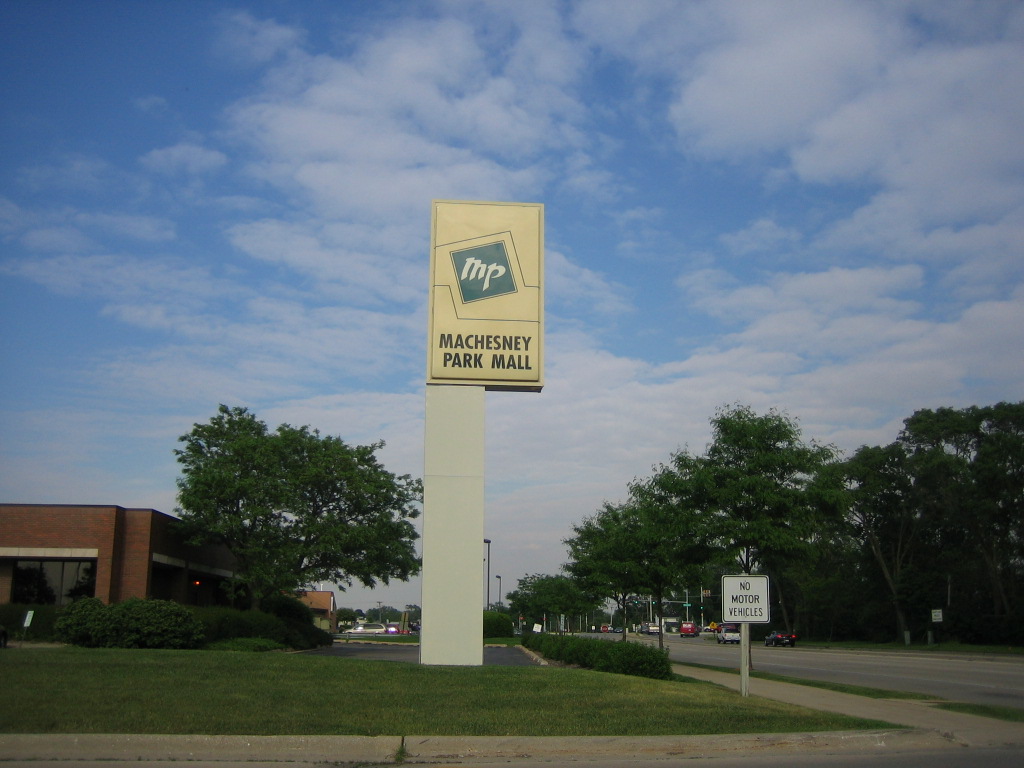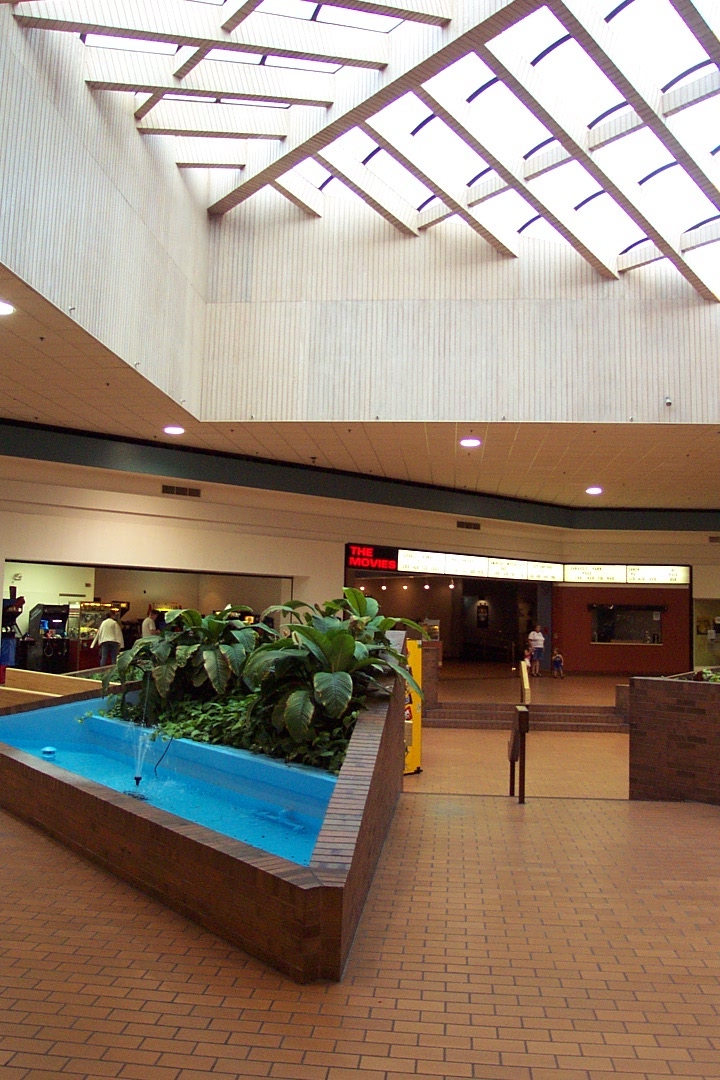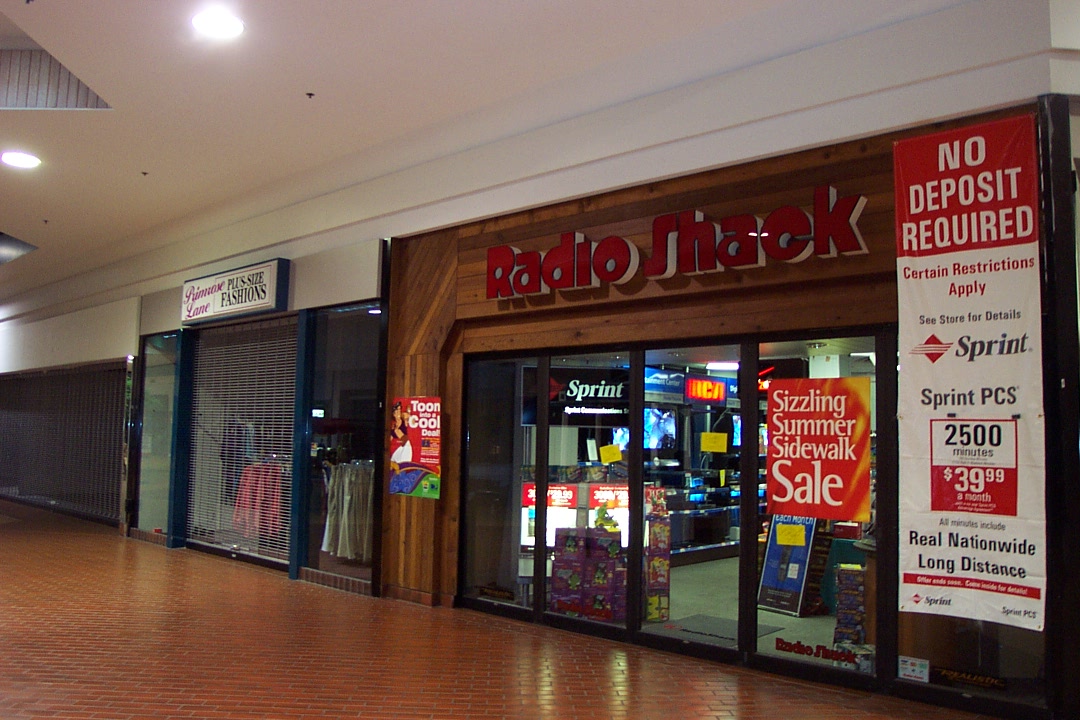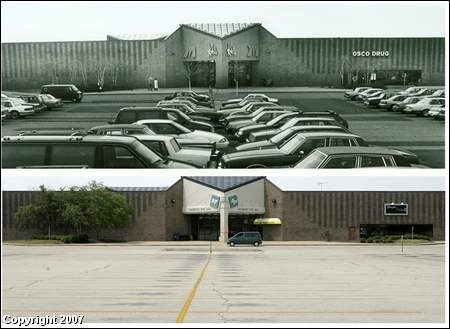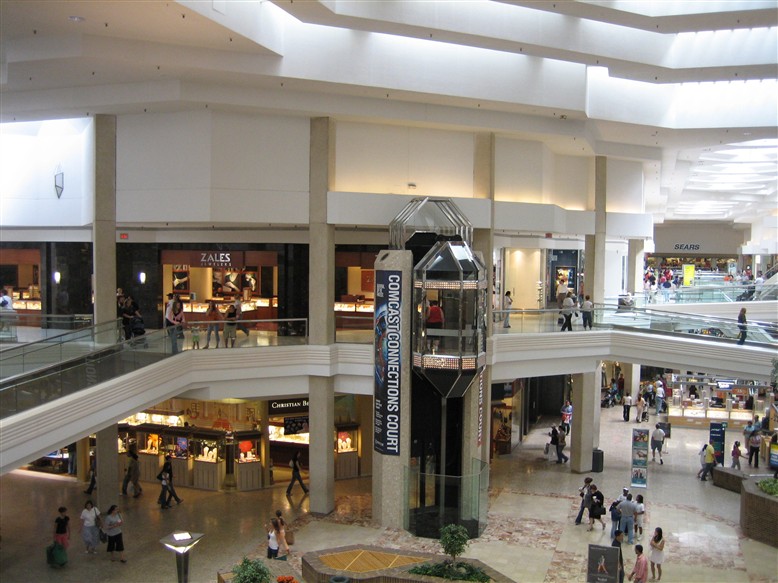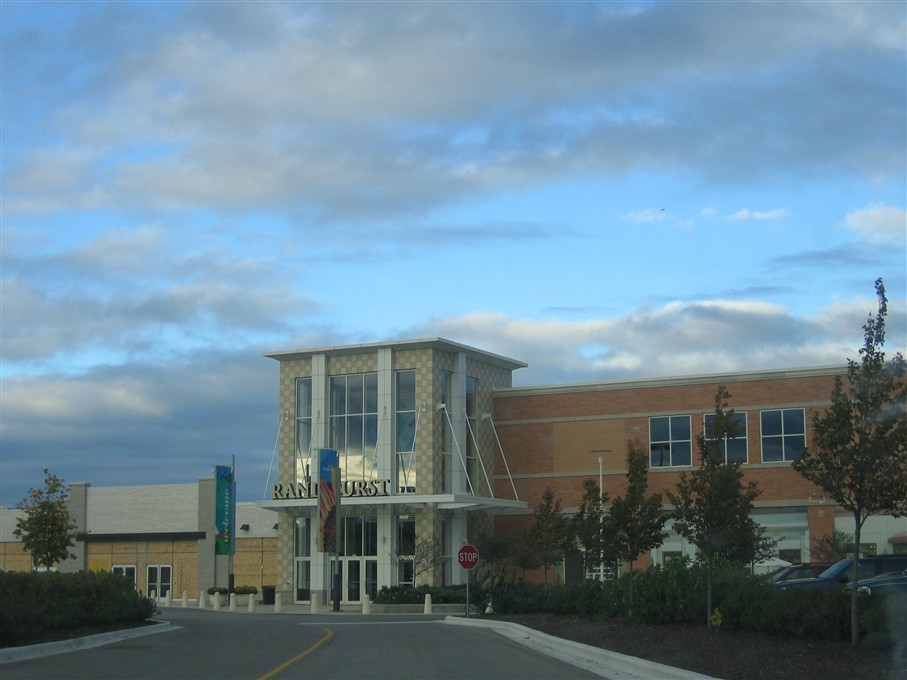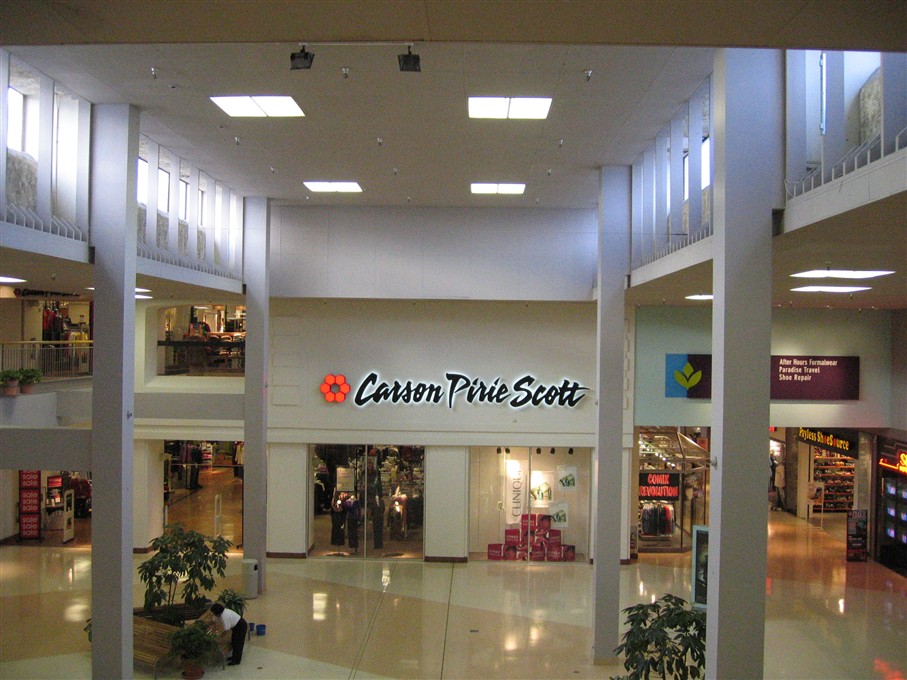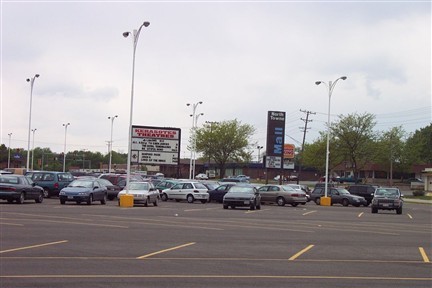Everyone carries pieces of nostalgia with them from childhood. They’re personal memories we can look back and reflect upon, and they generally make us feel warm inside and even give us a sense of pride. They evoke feelings of ‘way back when’ when things were indeed simpler for us. We didn’t have to worry about paying bills and living adult lives with their many responsibilities; instead, we worried about whether or not mom would let us buy some candy or a cool toy somewhere, or where we would go for lunch. Inherent with this sense of nostalgia comes place-making, or the fitting of our memories upon the physical places in which they occurred, thus giving the places richer meaning.
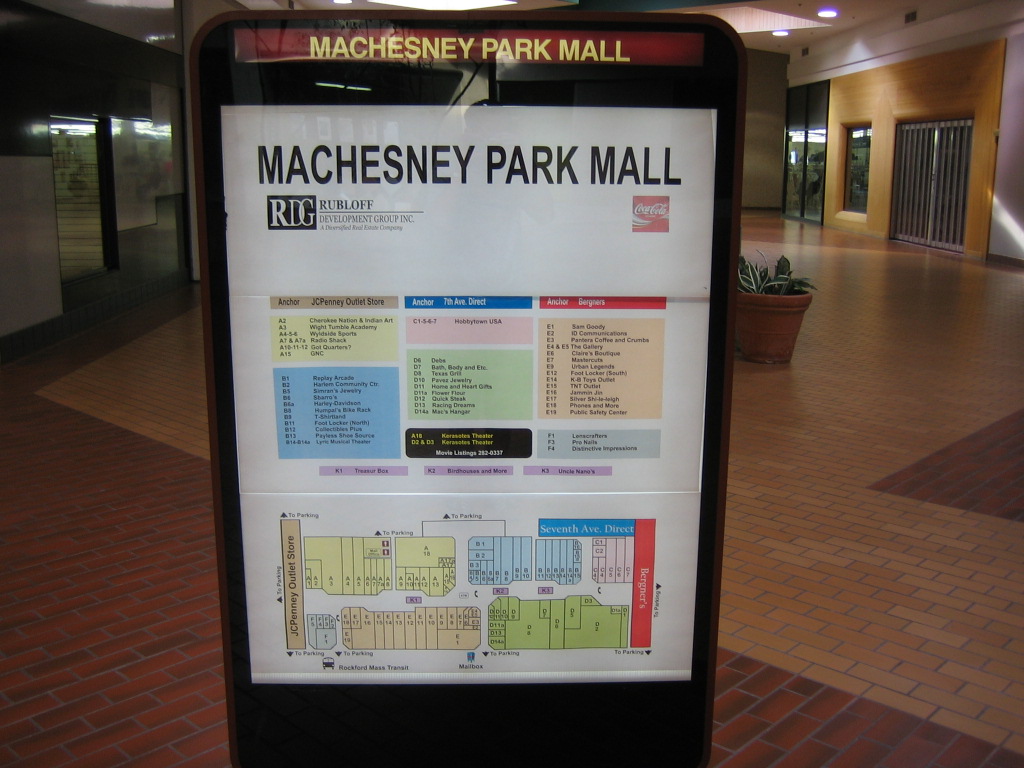 A place of my nostalgia includes the Machesney Park Mall (this website appears to have nothing to do with the mall; the pictures aren’t even from it) near Rockford, Illinois, which opened in 1979 and experienced over a decade of success before falling victim to mass exodus of stores starting in the late 1990s. The mall is currently in a perilous state, with only a handful stores out of a possible 80 open for business including 3 of the 4 anchor spaces; it is definitely a dead mall. And recently, the owner is exploring a total redevelopment of the site which almost certainly spells disenclosure for the mall.
A place of my nostalgia includes the Machesney Park Mall (this website appears to have nothing to do with the mall; the pictures aren’t even from it) near Rockford, Illinois, which opened in 1979 and experienced over a decade of success before falling victim to mass exodus of stores starting in the late 1990s. The mall is currently in a perilous state, with only a handful stores out of a possible 80 open for business including 3 of the 4 anchor spaces; it is definitely a dead mall. And recently, the owner is exploring a total redevelopment of the site which almost certainly spells disenclosure for the mall.
My memories of Machesney Park Mall stem to the late 1980s, starting around 1987 or 1988 when I was a little kid. My mom and I would drive from home in Janesville, Wisconsin south through Beloit, sometimes stopping at the mall there, and continue on down to Machesney Park which is just north of Rockford. We often went to this mall because it carried chains not available in Janesville like The Gap and Casual Corner, and had different anchors as well. It was also a newer mall, by comparison. Machesney Park Mall was built in 1979, whereas the other shopping centers in Rockford, Janesville, Beloit, and even Madison were built about a decade or more prior. The most important reason we went was its proximity from home and how easy it was to get there. My mom didn’t like driving on busy Interstate 90, and this mall was easy to reach via regular roads. It was also the closest of the malls in Rockford or Madison, which were and still are considered a step up from the malls in Janesville in Beloit, especially since the Beloit Mall closed up shop around the turn of the millenium following a tenuous struggle during most of the 1990s.
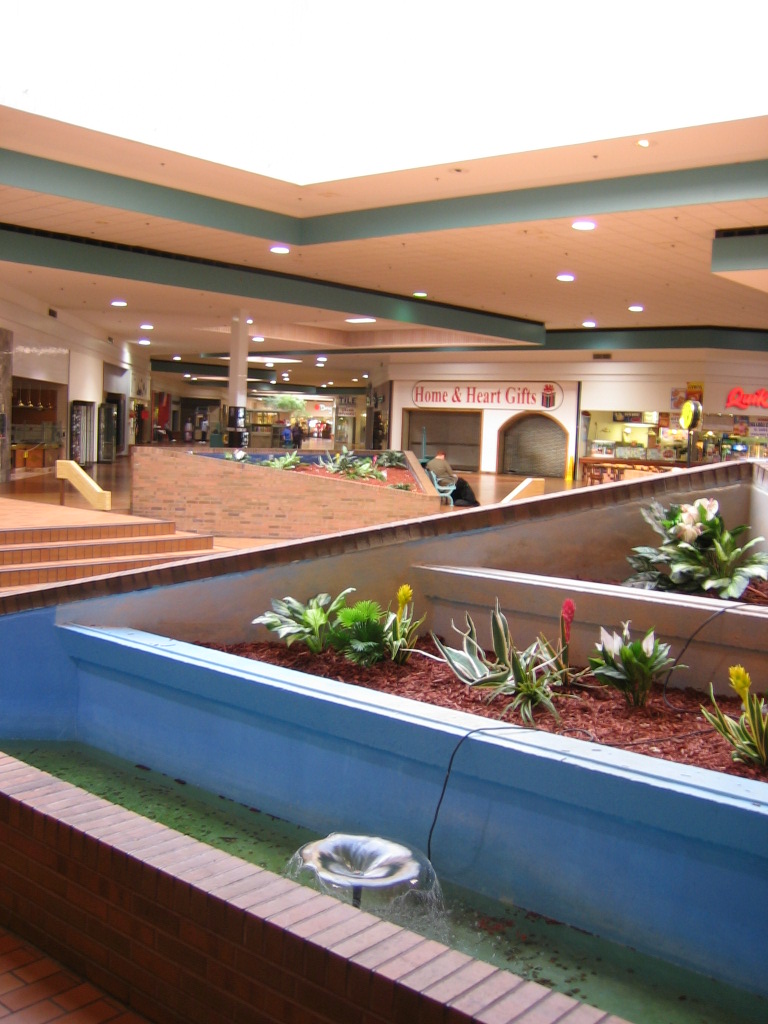 Once we got to Machesney Park Mall, we always parked at Prange’s, the north anchor (later Younkers and now Bergners, owned by Bon-Ton Stores). After extensive browsing by my mother at Prange’s, we’d enter the mall. Our first stop was often The Gap which was along the west-facing side of the mall corridor near Prange’s, opposite one of the movie theatres. That Gap location featured the company’s first logo which it used until 1983, visible in labelscar form here; this old logo has been resurrected more recently by the store itself on apparel. After The Gap, we’d stop in other stores such as Limited, Deb, Afterthoughts, or one of the shoe stores and my mom would continue shopping. I recall one of Machesney Park’s shoe stores, Baker’s Shoes, located about halfway down the corridor’s length on the east side. The store featured long, bright green shag carpeting; it didn’t remodel that look until after 2000. We also frequently stopped at Casual Corner, which was obviously one of their first prototypes featuring a colonial looking facade complete with amber stained glass lamps and elaborate showcase windows. It most frequently housed a bicycle store called Humpal’s Bike Rack which has since closed. Immediately next to the old Casual Corner was an old-school style Spencer’s Gifts featuring a lower-case swiveled logo not unlike the old Gap logo, with yellowish-orange paint along the store’s facade behind the sign. Spencer’s was still open as of 2001, but has closed since. After all the shopping we’d sometimes stop at Olga’s Kitchen, a chain of Michigan-based mostly mall-eateries which had a location along the east side of the mall corridor near one of the entrances from Highway 251. It closed many years ago, possibly over a decade ago, but the space was still being used recently as an area for families to sit and relax while shopping.
Once we got to Machesney Park Mall, we always parked at Prange’s, the north anchor (later Younkers and now Bergners, owned by Bon-Ton Stores). After extensive browsing by my mother at Prange’s, we’d enter the mall. Our first stop was often The Gap which was along the west-facing side of the mall corridor near Prange’s, opposite one of the movie theatres. That Gap location featured the company’s first logo which it used until 1983, visible in labelscar form here; this old logo has been resurrected more recently by the store itself on apparel. After The Gap, we’d stop in other stores such as Limited, Deb, Afterthoughts, or one of the shoe stores and my mom would continue shopping. I recall one of Machesney Park’s shoe stores, Baker’s Shoes, located about halfway down the corridor’s length on the east side. The store featured long, bright green shag carpeting; it didn’t remodel that look until after 2000. We also frequently stopped at Casual Corner, which was obviously one of their first prototypes featuring a colonial looking facade complete with amber stained glass lamps and elaborate showcase windows. It most frequently housed a bicycle store called Humpal’s Bike Rack which has since closed. Immediately next to the old Casual Corner was an old-school style Spencer’s Gifts featuring a lower-case swiveled logo not unlike the old Gap logo, with yellowish-orange paint along the store’s facade behind the sign. Spencer’s was still open as of 2001, but has closed since. After all the shopping we’d sometimes stop at Olga’s Kitchen, a chain of Michigan-based mostly mall-eateries which had a location along the east side of the mall corridor near one of the entrances from Highway 251. It closed many years ago, possibly over a decade ago, but the space was still being used recently as an area for families to sit and relax while shopping.
Not only do my memories of going to Machesney Park Mall as a child stir up warm nostalgia while tagging along and sharing quality time with my mom during her hours upon hours of shopping, but they typify for me what modern, succcessful malls in the 1980s were like. The dark tile, angular fountains and decorative skylights complemented the storefronts along the single corridor between Prange’s and JCPenney. Short side hallways to the west of the main corridor led to Prange Way, Kohl’s, and the other set of Movie Theatres. But the fountains don’t run anymore at Machesney Park and haven’t for a few years now, and the main corridor is completely barren save for a few people trying to get between the anchors without going outside. The mall essentially looks exactly as it did when my mom and I frequented it during the late 1980s, except most of the stores are empty and no one’s shopping there. Good for my reminiscing ability, bad for the mall.
Why did this mall fail? A specific combination of new development decisions, changing retail demographics, stepped up competition, and generally slower growth in the region’s economy precipitated Machesney Park Mall’s demise. Let’s go through the mall’s history to pinpoint where things started going downhill. Opened in 1979, the mall was a joint development between JCPenney and Simon to build a large mall on Rockford’s fast-growing north side. The communities of Roscoe, Rockton, Machesney Park, and Loves Park were all poised for growth, so it appeared especially prescient for them to build an enclosed mall there. Also, considering Rockford’s larger, two-level Cherryvale Mall is relatively far away on the far southeast side, the developers thought the mall would become a success.
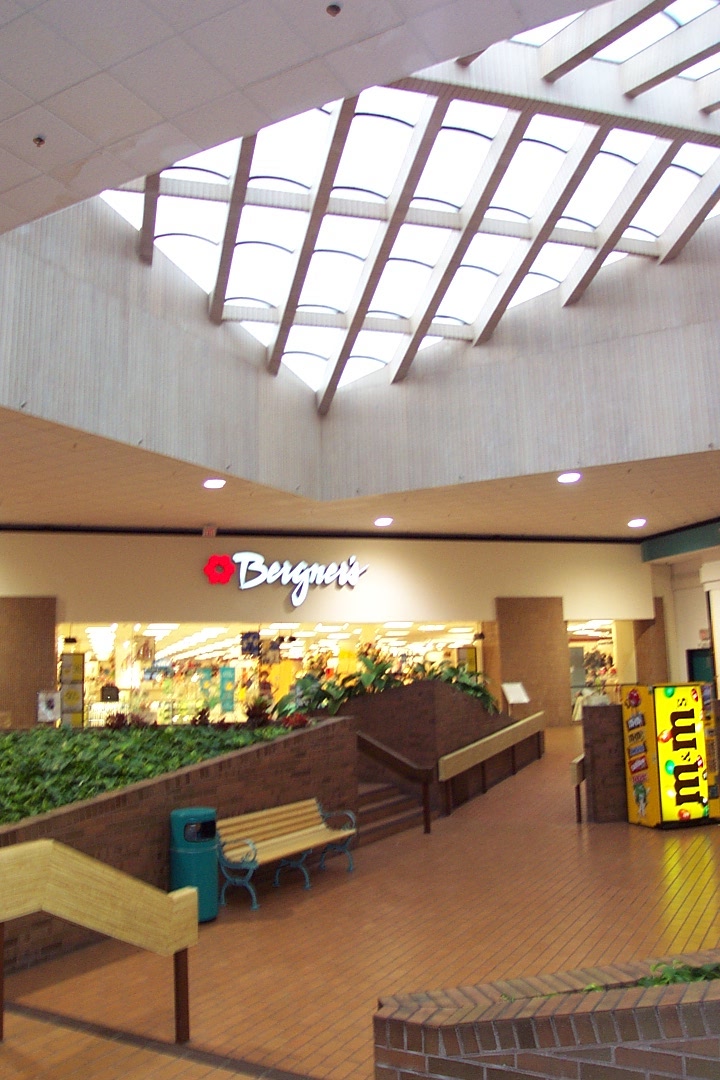 And it did. Just after opening, the mall added Kohl’s as a fourth anchor, rounding out the mall’s anchor roster along with Prange’s, a mid-tier department store based in Green Bay, Wisc., Prange-Way, a discount department store under the helm of Prange’s, and JCPenney. Remaining successful throughout the 1980s, the first blow to Machesney Park Mall occurred in 1990 with the closing of the Prange Way store, as a corporate restructuring saw them leave the Rockford market. That blow was softened in 1991 when Phar-Mor, a hybrid discount store/drug box chain based in Youngstown, Ohio, reclaimed the Prange Way space. Unfortunately, in 1992 Phar-Mor turned right around and closed their Machesney Park Mall store amid bankruptcy reorganization; their Rockford location remained open for almost another decade. Also in 1992, Prange’s went bust and was sold to Younkers, another mid-tier department store chain based in Des Moines, Iowa. Machesney Park Mall soldiered on mostly unscathed, still retaining 3 of its 4 anchor spaces after 1992 with JCPenney, Kohl’s, and Younkers, which became Bergner’s in a name change after both chains were purchased by Saks Incorporated and Saks decided to remove the Younkers name from the Madison, Milwaukee, and Rockford areas.
And it did. Just after opening, the mall added Kohl’s as a fourth anchor, rounding out the mall’s anchor roster along with Prange’s, a mid-tier department store based in Green Bay, Wisc., Prange-Way, a discount department store under the helm of Prange’s, and JCPenney. Remaining successful throughout the 1980s, the first blow to Machesney Park Mall occurred in 1990 with the closing of the Prange Way store, as a corporate restructuring saw them leave the Rockford market. That blow was softened in 1991 when Phar-Mor, a hybrid discount store/drug box chain based in Youngstown, Ohio, reclaimed the Prange Way space. Unfortunately, in 1992 Phar-Mor turned right around and closed their Machesney Park Mall store amid bankruptcy reorganization; their Rockford location remained open for almost another decade. Also in 1992, Prange’s went bust and was sold to Younkers, another mid-tier department store chain based in Des Moines, Iowa. Machesney Park Mall soldiered on mostly unscathed, still retaining 3 of its 4 anchor spaces after 1992 with JCPenney, Kohl’s, and Younkers, which became Bergner’s in a name change after both chains were purchased by Saks Incorporated and Saks decided to remove the Younkers name from the Madison, Milwaukee, and Rockford areas.
During the rest of the 1990s Machesney Park Mall began a slow trend downward, with many long-time retailers leaving such as Gap, The Limited, Casual Corner, Osco Drug and Foxmoor. Some were replaced with discounty, mom-and-pop style stores, but many became vacant. In 1997, JCPenney announced it would close its store at the mall after 18 years. However, the village of Machesney Park convinced them to stay and they did, becoming JCPenney Outlet Store in 1998. Also in 1998, the old Prange Way/Phar-Mor space retenanted after 6 years as Seventh Avenue Direct, a low-tier discount store with only one other known location in Davenport, Iowa. On the eve of the new millenium, Machesney Park Mall finally had all 4 anchors filled but was no longer a top-tier destination mall but instead was trending toward a discount or secondary mall.
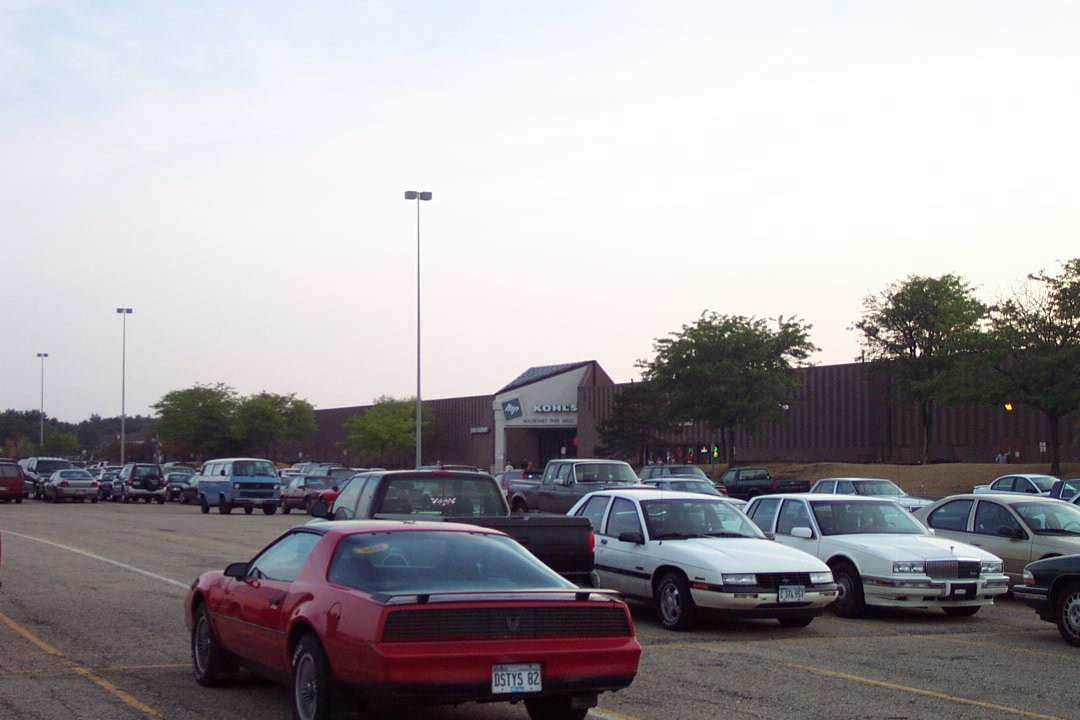 Changes since 2000 have essentially turned Machesney Park Mall from a potential gold mine as an ancillary, discount center to that of a ghost town destined for oblivion. In 2001, Kohl’s left Machesney Park for a strip mall in an emerging development near the intersection of Ill. 251 and Ill. 173, about 1 mile north of the mall. The new development at 173 and 251 has also brought a heap of new boxes, strip malls, and restaurants to Machesney Park, including Home Depot, Menard’s, Target, Gordman’s, Chili’s, Panera Bread, Del Taco, EB Games and more. A new interchange currently under construction will allow easy access from I-90 at Ill. 173 in early 2007. Unfortunately, all of this development is along this corridor and not near the mall itself. Notably, very few of Machesney Park Mall’s outlots have ever been developed, except for a Taco Bell and a Tom & Jerry’s fast food location. In fact, there is mostly residential development buffering the mall. The village of Machesney Park outwardly encouraged this new development along Ill. 173 to be closer to the new interchange and not near the mall. Why they did this is puzzling. Wouldn’t it make sense to put resources toward revitalizing the ailing enclosed mall rather than to encourage new development almost a mile away? All of these boxes and development could have been placed at or near Machesney Park Mall rather than where they were placed and all of this development has occurred over the past five years. In fact, businesses have been leaving Machesney Park Mall for the new development just north of it. GNC gave up the ghost inside the mall at the beginning of December 2006 for new digs at Ill. 173 and 251.
Changes since 2000 have essentially turned Machesney Park Mall from a potential gold mine as an ancillary, discount center to that of a ghost town destined for oblivion. In 2001, Kohl’s left Machesney Park for a strip mall in an emerging development near the intersection of Ill. 251 and Ill. 173, about 1 mile north of the mall. The new development at 173 and 251 has also brought a heap of new boxes, strip malls, and restaurants to Machesney Park, including Home Depot, Menard’s, Target, Gordman’s, Chili’s, Panera Bread, Del Taco, EB Games and more. A new interchange currently under construction will allow easy access from I-90 at Ill. 173 in early 2007. Unfortunately, all of this development is along this corridor and not near the mall itself. Notably, very few of Machesney Park Mall’s outlots have ever been developed, except for a Taco Bell and a Tom & Jerry’s fast food location. In fact, there is mostly residential development buffering the mall. The village of Machesney Park outwardly encouraged this new development along Ill. 173 to be closer to the new interchange and not near the mall. Why they did this is puzzling. Wouldn’t it make sense to put resources toward revitalizing the ailing enclosed mall rather than to encourage new development almost a mile away? All of these boxes and development could have been placed at or near Machesney Park Mall rather than where they were placed and all of this development has occurred over the past five years. In fact, businesses have been leaving Machesney Park Mall for the new development just north of it. GNC gave up the ghost inside the mall at the beginning of December 2006 for new digs at Ill. 173 and 251.
Further agonizing Machesney Park Mall is other competition in Rockford, most notably Cherryvale Mall on the far southeast side of town. Immediately adjacent to Interstates 90/39 and U.S. 20, Rockford’s southern belt, Cherryvale has undoubtedly always been the dominant retail center in Rockford since it opened in the early 1970s. It’s larger at two-stories with 134 stores, and contains a top-tier roster of both anchors and in-line store space. But in 2004, it renovated its dated look and added JCPenney as an anchor, further strengthening its position in Rockford. Cherryvale is also located near the center of retail for the Rockford area, East State Street, which is lined for miles with boxes, restaurants, and strip malls galore. Highway 251/North Second St. has always been an ancillary strip corridor, but has never been up to par with the offerings on E. State St. Furthermore, with the new development at 173/251, Machesney Park Mall stands virtually no chance.
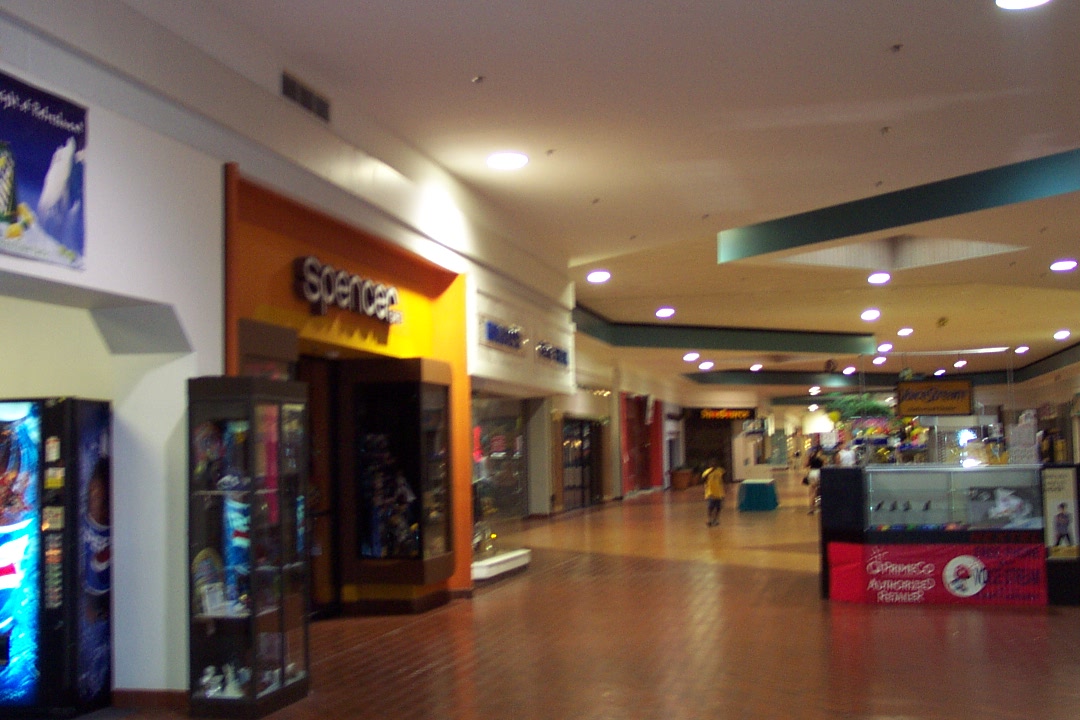 In fact, its time may finally be up. Since Kohl’s left in 2001, stores have been bleeding from Machesney Park Mall. In 2002, Simon unloaded the mall on local rockford real estate developer Rubloff. That same year, Waldenbooks and Rogers & Hollands closed. In 2003, Kay-Bee Toys and Sam Goody closed. In 2004, the popular HobbyTown USA closed and relocated away from the mall. Also during 2004, talks stirred of redevelopment but never went anywhere. In 2006, Lens Crafters, Deb Shops and Foot Locker closed, with the former relocating in a new strip mall along Ill. 173 about a mile north. JCPenney Outlet, Bergner’s, and Seventh Avenue are still open and remain mostly unaffected by the mall’s demise. In fact, the anchors are independently owned and the JCPenney Outlet is a very busy and profitable location.
In fact, its time may finally be up. Since Kohl’s left in 2001, stores have been bleeding from Machesney Park Mall. In 2002, Simon unloaded the mall on local rockford real estate developer Rubloff. That same year, Waldenbooks and Rogers & Hollands closed. In 2003, Kay-Bee Toys and Sam Goody closed. In 2004, the popular HobbyTown USA closed and relocated away from the mall. Also during 2004, talks stirred of redevelopment but never went anywhere. In 2006, Lens Crafters, Deb Shops and Foot Locker closed, with the former relocating in a new strip mall along Ill. 173 about a mile north. JCPenney Outlet, Bergner’s, and Seventh Avenue are still open and remain mostly unaffected by the mall’s demise. In fact, the anchors are independently owned and the JCPenney Outlet is a very busy and profitable location.
Recently in the Rockford Register-Star, buzz has been once again generated about the mall’s redevelopment. They are in the process of exchanging ideas about what to do with the failed mall, and most ideas which have surfaced have involved disenclosing the indoor portion of the mall and building a strip mall in its place. That way, the stores will face Ill. 251 directly and so will the anchors, Bergner’s and JCPenney Outlet. Other ideas involve invoking the ever-popular Lifestyle Center idea, bringing office space, residential, and retail to the mix.
To me, Machesney Park Mall’s failure represents our wasteful throwaway society. The mall, or at least parts of it, could have been saved by placing all or parts of the new development there, instead of building anew and creating more sprawl. It could have had continued success despite the changing retail demographics and competition and repositioned as a discount or even an outlet mall. Instead, the decision was made to allow the mall to fail completely, and that’s such a shame. I’ll probably go down and visit one last time before the doors are shut for good and the inevitable wrecking ball comes to reclaim the physical structure of my childhood nostalgia. But hey, I’ll always have the memories.
UPDATE 5/23/07: The other shoe has dropped. Rubloff has announced a massive redevelopment for the site, including the demolition of the center court area which will begin in June. Replacing it will be a tree-lined street with fountains, and the rest will become a focal point for the Village of Machesney Park. It will not only feature retail, but a place for festivals, living space, and more. The two anchors which remain currently, JCPenney Outlet and Bergners, will stay in their spaces. More detailed plans will be announced in the coming weeks.
It’ll be interesting to see if they keep any of the mall’s superstructure or even leave any enclosed space whatsoever. I’m also not sure what kind of retail would want to be at this site, considering most of it has recently clustered about a mile north at the intersection with IL 173 which will very soon have an interchange with I-90/39, spurring even more growth. I suppose if they make it attractive enough, and indeed promote it as the centerpiece for the community, the ‘if you build it, they will come’ mentality may cause an inflow of businesses to the long-abandoned site.
I took the following pictures in July 2001. Note that many stores seem closed, but were actually just closed for the night. As usual, feel free to leave your comments and observations.
These pictures were taken in June 2005. Since then, most of these stores have also closed.
Finally, here are some awesome vintage pics courtesy of John Gallo. They are most likely from the early 80s save for the Younkers one which is from the 90s. I especially love the vintage cursive Kohl’s sign and obviously, Prange Way.
